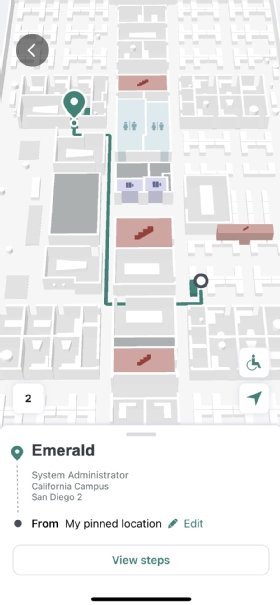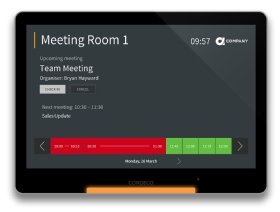
Getty Images
Wayfinding tools chart course for hybrid office
Wayfinding tools, which make use of apps, maps, electronic signage and wireless tech, are being targeted by HR for hybrid offices. The capability may include employee tracking.
Employees returning to the hybrid office may rely on apps, maps and electronic signage to find their desks. These positioning technologies and mapping services are broadly called wayfinding tools, and demand may grow.
Employees returning to the office may have to reserve desks in potentially unfamiliar spaces, and -- if hot desking becomes the norm -- their desk locations may differ with each office visit. They'll also have to track down coworkers and meeting spaces in this new organizational structure and won't want to waste a lot of time. Vendors are adopting various approaches to solve problems posed by hybrid office routines.
Wayfinding products use app-based map systems and electronic signage to orientate employees and provide real-time status updates on meeting room occupancies. Employees may also be able to use this positioning technology to learn the location of co-worker desks from one office visit to the next. HR often works closely with facilities managers in their deployment.
Based on research conducted in October, IDC estimates that 20% of organizations globally with 500 or more employees have either already invested in wayfinding technology or are planning to do so, said Juliana Beauvais, an analyst at IDC.
"This brings indoor navigation technology from a niche application in event, transportation and large retail locations to broader settings such as offices, healthcare campuses, educational institutions and public-sector facilities," she said.
With fewer trips to the office or a need to work at multiple locations, employees will "start behaving like visitors," Beauvais said. These changes will motivate employers to deploy wayfinding products, she said.
Kevin Nanney, vice president and general manager of workplace service delivery at ServiceNow, explained, "As employees go back to the office, a lot of them have never seen it."

ServiceNow just updated its Workplace Service Delivery facilities management mobile app with wayfinding location services that can guide an employee, step-by-step, to a desk or meeting room. They are using third-party partnerships for indoor positioning technology used in wayfinding, Wi-Fi, Bluetooth Low Energy or other technology to build that capability.
The ServiceNow workplace platform can make reservations for desks, meetings rooms and lockers, as well as services such as catering. Employers can make employee check-ins visible to other employees. Calendaring system integrations make it possible to use the app to see a co-worker's availability. The vendor also added proximity-based reservation capability for sharing reservation itineraries and booking desks near co-workers.
A related aspect of enterprise wayfinding tools is employee tracking, which can show real-time employee locations. Although a client could add it, real-time employee tracking isn't a feature in ServiceNow's workplace platform. But this tracking technology is in use.
Real-time employee tracking
Employee badges, for instance, can use Bluetooth-enabled transmitters, powered by a coin cell battery, to send out a signal once or twice a second to a receiver. An algorithm can calculate the distance between the person and receiver based on the amount of power received, said Ken Kolderup, chief marketing officer at Bluetooth Special Interest Group (SIG). About two years ago, SIG added direction-finding, which can calculate the direction someone is moving.
These employee data collection systems can be private or open, Kolderup said. They can anonymize employee identification and use the data to track the flow of people to analyze, for instance, office space utilization. In some cases, such as for production line or mine workers, location-based employee tracking can help with safety, Kolderup said.
Firms that deploy these systems can create "blackouts" in specific office areas such as bathrooms to prevent tracking. Indeed, Bluetooth can also be used entirely for navigating a building and not employee tracking, operating similar to GPS on a smartphone.
Even though the technology is available to track individual workers, vendors have refrained from adding the functionality into their platforms due to privacy concerns.
One firm, Avuity LLC, a space utilization software and occupancy sensor firm in Cincinnati, said employee tracking is a concern with firms. "They don't want to be perceived as Big Brother spying on their workers," a firm spokesman said.
Paul Statham, CEO and founder of Condeco Software Inc., a workspace management vendor based in London, agreed. "It's hugely unpopular to track people in buildings," he said. "It goes against a lot of the data privacy standards."

Statham, whose firm makes workplace management tools, including room and desk booking systems and calendar software, doesn't see the need for wireless wayfinding tools because they are expensive and complex. Instead, Condeco Software's systems can tell employees what building to enter, where their colleagues are and where they can book a desk or room. He said employees can see the spaces available to them, something HR maps.
Most buildings have "very good visual wayfinding within the floors," Statham said. People are in the habit of using signs alone, he argued. He said he also believes that the wayfinding technology is too costly.
Condeco also has systems that put small screens on a desk with an employee's name to help employees find their desks. It uses meeting room display screens outside the meeting room that relay information, such as the organizer and time.
"We find our way around unfamiliar places like airports and car parks by using very good static signs," he said.
Patrick Thibodeau covers HCM and ERP technologies for TechTarget. He's worked for more than two decades as an enterprise IT reporter.






